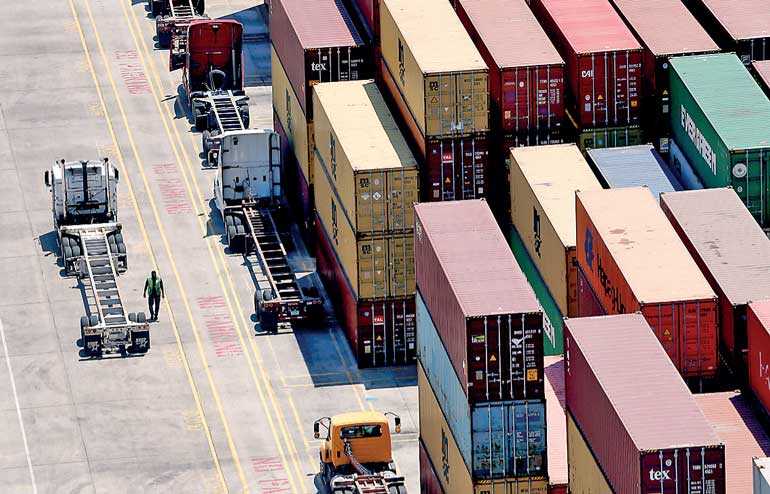Tuesday Mar 11, 2025
Tuesday Mar 11, 2025
Monday, 16 July 2018 00:00 - - {{hitsCtrl.values.hits}}

Workers stack empty shipping containers for storage at Wando Welch Terminal operated by the South Carolina Ports Authority in Mount Pleasant, South Carolina, US - REUTERS
LOS ANGELES (Reuters) - Chinese imports to U.S. ports rose more than expected in June, suggesting that some retailers moved up orders to insulate themselves from an intensifying trade war that threatens to send up costs on a growing number of consumer products.
Retailers such as Walmart Inc and Amazon.com face uncertainty due to U.S. President Donald Trump’s threat to impose more tariffs on Chinese goods, and the jump in imports from the country was likely because of “pre-emptive buying in anticipation of the tariffs”, said Ben Hackett, founder of international maritime consultancy Hackett Associates.
“This is a bump that isn’t quite normal,” he said.
The U.S. container port peak season is traditionally driven by orders for Chinese-made clothing, electronics and toys for the back-to-school season running from June to September, and then the winter holiday season.
The volume of loaded shipping containers from China to all U.S. ports was up 6.3% in June from a year earlier after falling 6.9% in May and 3.9% in April, said Gene Seroka, executive director of the Port of Los Angeles, the busiest U.S. container port and No. 1 hub for ocean trade with China.
Seroka’s data was sourced from IHS Markit’s PIERS and analyzed by Port of Los Angeles staff.
Data about specific products and buyers, which is compiled from paperwork filed when goods are delivered, was not immediately available.China said on Friday exports unexpectedly accelerated in June. Officials previously said that Chinese exporters were front-loading shipments to the United States to get ahead of expected tariffs.
Walmart and Amazon declined to comment.Trump has vowed to reset the United States’ global trade agreements, which includes a threat to impose tariffs on more than $500 billion worth of Chinese goods. Retailers, who place orders for general merchandise up to a year in advance, can offset additional costs by raising prices or finding new suppliers in countries not subject to import levies.
On July 6, the U.S. imposed 25% tariffs on $34 billion of Chinese goods, including flash drives, remote controls and thermostats, from a list of $50 billion in products first proposed in April. China quickly fired back with tariffs on an equal value of U.S. goods, including soybeans, whiskey, cotton and automobiles.
Those are unlikely to immediately affect retailers.
The Trump administration raised the stakes in the trade battle on Tuesday with a plan to add 10% tariffs on $200 billion worth of Chinese goods, including furniture, handbags, pet food, refrigerators, textiles and auto parts.
That new round could hit during the autumn lead-up to the all-important Christmas and winter holidays. Many products purchased for that season will have arrived at ports well ahead of the imposition of the new levies.
Discover Kapruka, the leading online shopping platform in Sri Lanka, where you can conveniently send Gifts and Flowers to your loved ones for any event including Valentine ’s Day. Explore a wide range of popular Shopping Categories on Kapruka, including Toys, Groceries, Electronics, Birthday Cakes, Fruits, Chocolates, Flower Bouquets, Clothing, Watches, Lingerie, Gift Sets and Jewellery. Also if you’re interested in selling with Kapruka, Partner Central by Kapruka is the best solution to start with. Moreover, through Kapruka Global Shop, you can also enjoy the convenience of purchasing products from renowned platforms like Amazon and eBay and have them delivered to Sri Lanka.
Discover Kapruka, the leading online shopping platform in Sri Lanka, where you can conveniently send Gifts and Flowers to your loved ones for any event including Valentine ’s Day. Explore a wide range of popular Shopping Categories on Kapruka, including Toys, Groceries, Electronics, Birthday Cakes, Fruits, Chocolates, Flower Bouquets, Clothing, Watches, Lingerie, Gift Sets and Jewellery. Also if you’re interested in selling with Kapruka, Partner Central by Kapruka is the best solution to start with. Moreover, through Kapruka Global Shop, you can also enjoy the convenience of purchasing products from renowned platforms like Amazon and eBay and have them delivered to Sri Lanka.